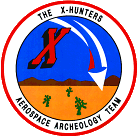
 |
I asked noted aviation authors Chris Pocock and Curtis Peebles if they had any more specific information. Both suggested that I was wasting my time. Even if I could find the site, there were several factors working against me. First of all, the aircraft was operated by the CIA and was highly classified at the time. Although it had first flown in 1955, its existence wasn't announced until 1956 (and with an elaborate cover story!). The first photo of the U-2 wasn't released until February 1957. Secondly, this aircraft crashed while in the "dirty bird" configuration, covered with secret radar absorbent materials, which would have been more of a reason to clean up the site. Thirdly, it crashed in a flat spin. All witness accounts described the aircraft as "intact" following impact.
Undaunted, I pressed for more information. Chris offered that a member of the recovery crew described the crash site as being "about 300 or 400 feet south a of big wash, where we landed several light planes during the recovery." Now I felt I had something to work with. According to maps of the area, most of the washes ran from north to south, and only one seemed to run generally from west to east, draining into the White River. In the summer of 1994, I ordered aerial photos from the U.S. Geological Survey, covering nearly 300 square miles. About 30 square miles appeared to fall within a promising search area. The west-east wash appeared to be very large. This seemed to bode well, since I knew it had to be large enough for airplanes to land on. If that was the correct wash, then my search area could be reduced to about five square miles. I could not identify any feature on the photos that appeared to be a crash site, and it seemed like a great deal of territory to cover on foot.
Around this time, Tom Mahood was searching for wreckage of a Lockheed A-12 that crashed in southern Nevada in 1967. As part of his research, he requested the pilot's death certificate from the Nevada Office of Vital Statistics in Carson City. The death certificate gave an incredibly detailed description of the location of the pilot's body. This didn't help Tom find the crash site, since the pilot had come down nearly 10 miles away from the aircraft. In the case of the U-2, however, the pilot landed very near the aircraft. I requested Robert Sieker's death certificate in early December 1995. The location it gave was a "rural" area of Nye County "near Tonopah." This was even less helpful than the newspaper article had been.
On 12 December 1995, I wrote to the Air Force Safety Agency (AFSA) at Kirtland AFB, New Mexico for a copy of the accident investigation report. I even made it a Freedom of Information Act (FOIA) request. In a response dated 3 January 1996, the AFSA vice commander stated that his staff had been unable to locate such a report.